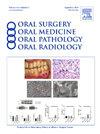Oral lesions in a dyskeratosis congenital patient treated with bone marrow transplantation: challenges in differential diagnosis
IF 1.9
3区 医学
Q2 DENTISTRY, ORAL SURGERY & MEDICINE
Oral Surgery Oral Medicine Oral Pathology Oral Radiology
Pub Date : 2025-07-21
DOI:10.1016/j.oooo.2025.04.078
引用次数: 0
Abstract
Background
Dyskeratosis congenita (DKC) represents a rare hereditary disorder resulting from mutations in DKC-1 gene usually displaying an X-linked recessive trait. The classic clinical triad of DKC includes hyperpigmentation of the skin, nail dystrophy, and white plaques of the oral mucosa, along with a high incidence of aplastic anemia development. Herein, a well-documented case of DKC is described with emphasis on differential diagnostic dilemmas.
Case Description
A 25-year-old male, nonsmoker, and nonalcohol drinker, was referred for evaluation of long-standing oral white lesions. The patient had a molecularly-confirmed diagnosis of DKC since age 8 for which he underwent hematopoietic stem cell transplantation (HSCT) at age 11. A history of oral painful lesions, first noticed a few years after birth, was also reported; following HSCT, oral white and ulcerative lesions were periodically managed with topical immunosuppressive regimens. On clinical intraoral examination, multifocal nondetached oral white patches and prominent atrophy of the dorsal tongue were evident; in addition, loss of elasticity of the oral tissues with fibrous bands of the buccal mucosa and limited mouth opening were also observed, raising the possibility of sclerodermatous chronic graft-versus-host disease (cGVHD). Further, cutaneous reticular hyperpigmentation, dystrophic nails, and alopecia were present. Biopsies of tongue white lesions showed dysplastic changes. Laser ablation of the residual white lesions and close follow-up appointments were suggested.
Discussion and Conclusions
Oral white plaques in DKC patients exhibit a significant potential for malignant transformation; concomitant cGVHD development in HSCT recipients is possible and might perplex the diagnosis of oral lesions. Biopsy and histopathologic evaluation of suspicious lesions are essential for diagnosis and risk assessment of malignant transformation, while close monitoring is also of high importance. Oral manifestations DKC and cGVHD may show significant overlap, while both conditions may coexist and potentially synergistically contribute to the risk of malignant transformation.
骨髓移植治疗先天性角化不良患者的口腔病变:鉴别诊断的挑战
先天性角化病(DKC)是一种罕见的遗传性疾病,由DKC-1基因突变引起,通常表现为x连锁隐性性状。DKC的典型临床三联征包括皮肤色素沉着、指甲营养不良和口腔黏膜白色斑块,并伴有再生障碍性贫血的高发。在这里,一个充分记录的情况下,DKC被描述与重点鉴别诊断困境。病例描述:一名25岁男性,不吸烟,不饮酒,被转介评估长期口腔白色病变。患者自8岁起被分子确诊为DKC,并在11岁时接受了造血干细胞移植(HSCT)。出生后几年首次发现的口腔疼痛病变史也有报道;HSCT后,口腔白斑和溃疡性病变定期用局部免疫抑制方案治疗。临床口腔内检查,多灶性非分离性口腔白斑和舌背明显萎缩;此外,还观察到口腔黏膜纤维带组织弹性丧失和张嘴受限,增加了硬化性慢性移植物抗宿主病(cGVHD)的可能性。此外,皮肤网状色素沉着,指甲营养不良和脱发。舌白色病变活检显示发育不良。建议激光消融残余白色病灶并密切随访。讨论与结论DKC患者口腔白色斑块具有明显的恶性转化潜力;HSCT受者可能同时出现cGVHD,这可能会使口腔病变的诊断变得困难。可疑病变的活检和组织病理学评估是恶性转化诊断和风险评估的必要条件,密切监测也非常重要。口腔表现DKC和cGVHD可能有明显的重叠,而这两种情况可能共存,并可能协同促进恶性转化的风险。
本文章由计算机程序翻译,如有差异,请以英文原文为准。
求助全文
约1分钟内获得全文
求助全文
来源期刊

Oral Surgery Oral Medicine Oral Pathology Oral Radiology
DENTISTRY, ORAL SURGERY & MEDICINE-
CiteScore
3.80
自引率
6.90%
发文量
1217
审稿时长
2-4 weeks
期刊介绍:
Oral Surgery, Oral Medicine, Oral Pathology and Oral Radiology is required reading for anyone in the fields of oral surgery, oral medicine, oral pathology, oral radiology or advanced general practice dentistry. It is the only major dental journal that provides a practical and complete overview of the medical and surgical techniques of dental practice in four areas. Topics covered include such current issues as dental implants, treatment of HIV-infected patients, and evaluation and treatment of TMJ disorders. The official publication for nine societies, the Journal is recommended for initial purchase in the Brandon Hill study, Selected List of Books and Journals for the Small Medical Library.
 求助内容:
求助内容: 应助结果提醒方式:
应助结果提醒方式:


